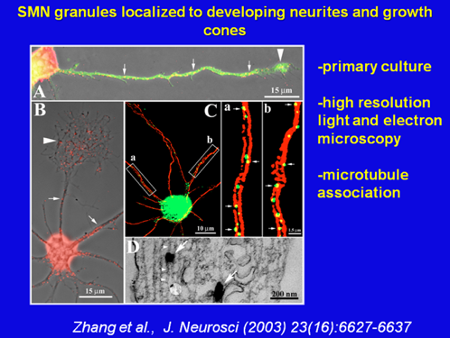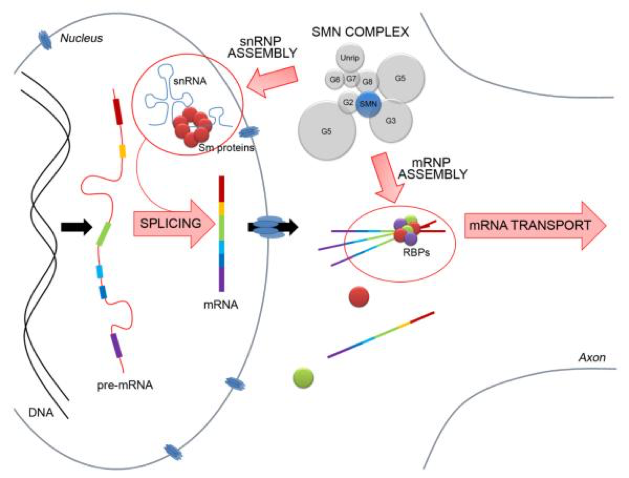Role of the Survival of Motor Neuron protein (SMN) in the mechanism of mRNA localization, and impairments in mRNA localization in a mouse model of spinal muscular atrophy (SMA)

Our research has provided new insight into the disease mechanism for spinal muscular atrophy, a genetic neurodegenerative disease that is caused by low levels of the survival of motor neuron protein, Smn, which has been well studied for its ubiquitous function in the assembly of snRNPs and splicing. Our work has uncovered a non-canonical role of Smn to facilitate the localization of mRNA transport granules in axons of motor neurons (Fallini et al., Journal of Neuroscience 2011).
 This paper was the first report of global impairments in axonal mRNA localization in motor neurons of a mouse model of SMA, and the characterization of a mechanism for the role of Smn in mRNA localization through its interaction with the neuronal mRNA binding protein, HuD. This work followed from our discovery of SMN transport in axons of motor neurons (Zhang et al., Journal of Neuroscience 2003) and the composition of SMN transport granule (Zhang et al., Journal of Neuroscience 2006). More recently we have shown the role of SMN interactions with the mRNA binding protein IMP1 to facilitate axonal localization (Fallini et al., Dev. Neurobiol. 2014).
This paper was the first report of global impairments in axonal mRNA localization in motor neurons of a mouse model of SMA, and the characterization of a mechanism for the role of Smn in mRNA localization through its interaction with the neuronal mRNA binding protein, HuD. This work followed from our discovery of SMN transport in axons of motor neurons (Zhang et al., Journal of Neuroscience 2003) and the composition of SMN transport granule (Zhang et al., Journal of Neuroscience 2006). More recently we have shown the role of SMN interactions with the mRNA binding protein IMP1 to facilitate axonal localization (Fallini et al., Dev. Neurobiol. 2014).
 The current model under study is that SMN functions to facilitate the assembly of mRNP transport granules (Fallini et al., Brain Research 2012). This is a non-canonical function but related mechanistically to its function in snRNP assembly.
The current model under study is that SMN functions to facilitate the assembly of mRNP transport granules (Fallini et al., Brain Research 2012). This is a non-canonical function but related mechanistically to its function in snRNP assembly.
